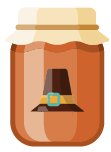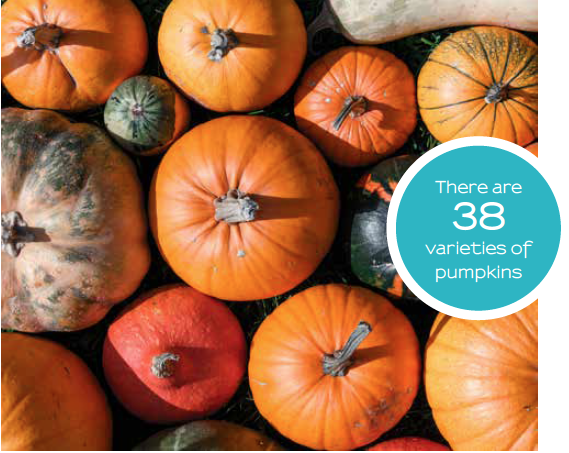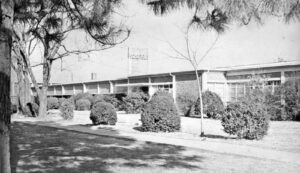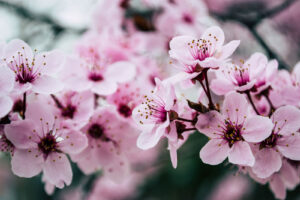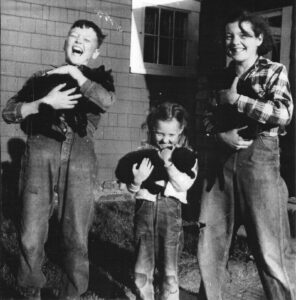Let’s Give Them Pumpkin to Talk About.
Strips of pumpkin lying on the ground gave up their moisture to the sun as American Indians gathered them to weave into mats. Other slices of pumpkin surrounded their open fires in preparation for the next meal. When white colonists took possession of their land, they learned from the American Indian how to use this new food in stews, soups, and desserts.
The pumpkin pie was created by white women who cut off the pumpkin top, removed seeds, then filled the hollow pumpkin with milk, spices, and honey and baked it in dying coals. The result was a custard-like dessert where pumpkin was the crust. Pumpkin pies were substituted for minced meat pies at Thanksgiving because Puritans declared them to be “unholy.”
A Sip of Flip
To many English settlers, beer was a staple in their daily diet. Good malt was not in supply in early America; pumpkin was easy to grow so the Pilgrims substituted it for malt to brew beer. The colonists mixed pumpkin beer with rum and sugar and filled their mugs with “flip,” a New World original brew. It proved to be inspiration for what is believed to be America’s earliest folk song, written in 1643:
 Instead of pottage and puddings and custards and pies
Instead of pottage and puddings and custards and pies
Our pumpkins and parsnips are common supplies;
We have pumpkin at morning and pumpkin at noon;
If it was not for pumpkins we should be undone.
Hey down, down, hey down Derry down.
If barley be wanting to make into malt
We must be contented and think it no fault
For we can make liquor to sweeten our lips
Of pumpkins and parsnips and walnut tree chips.
Pumpkin beer soared in popularity in the colonies during the 1700s, but Europeans snubbed it.
Today most pumpkin beers taste like pumpkin pie in a mug, using nutmeg and cloves for flavor. A few breweries actually use pumpkin in their recipes. While modern pumpkin ales and beer recipes may be worlds away from the original beer, drinkers can still enjoy a tasty pumpkin brew.
Mastodons, Elephants, and People
Even before pumpkins were spreading on the vine in North America, more than 5,000 years ago the mastodon was munching on the bitter varieties of pumpkin. Seeds discovered in dung fossils are evidence that these wooly prehistoric mammoths ate pumpkin. Their closest surviving relatives are the African elephants that still devour several kinds of bitter squash. Zoos in the United States toss pumpkins to elephants which smash and eat them like their prehistoric relatives.
The oldest planted seeds in the Americas were discovered by archaeologists in the Oaxaca Highland in Mexico. Originating over 7,500 years ago in Central America, wild pumpkins were small and tough with a bitter taste. North American Indians grew pumpkins as one of the first edible crops. They were easy to store during cold weather and provided sustenance when other food was scarce.
Easy to cultivate, pumpkins became the staple of the American rural poor. Europeans scoffed at this crop and the people who ate them, considering both to be low in status. But colonists in New England celebrated the availability of pumpkins, using them in soups, stews, sauces, and meal basics.
Baby Boo and Casper, Too
Orange pumpkins fill boxes and shelves in grocery stores each fall, but there are hundreds of varieties of pumpkins.
- Baby Boo are palm-sized white minis great for decorating but not cooking or carving.
- Lumina also are brilliant white, and can be cooked and carved.
- Casper and White Ghost are bright white and edible.
- Miniatures include We-B-Little, Munchkin, and Jack-Be-Little.
- The Porcelain Doll is pink and has a sweet meat which tastes good in soups, pies, and gourmet recipes.
- Cinderella pumpkins were named after the Disney classic and are various shades of orange.
- Turbans are not really pumpkins but edible squash. Resembling a hat or turban, they are orange with veins of white and green.
The Legend of Stingy Jack
Ever wonder why a carved pumpkin is called a “Jack O’Lantern?”
The Irish tell a story about a man named “Stingy Jack” who asked the Devil to meet him at a tavern for a drink. Hating to part with his money, Jack persuaded the Devil to magically become a coin so he could pay their tab. The Devil did, but Jack slipped the coin into his pocket to keep the money for himself. He also inserted a silver cross into his pocket which kept the Devil from using his power to return as himself. The Devil was freed after Jack made him promise not to trouble him for a year and if Jack should die, the Devil would not take his soul.
But next year Jack was at it again. He tricked the Devil into climbing a tree to steal a piece of fruit. While up the tree, Jack carved a cross into the trunk which meant the Devil could not come down. Jack relented and helped him out of that predicament after getting a promise from the Devil not to bother him for ten more years.
Then Jack died.
After God banned his soul from heaven, the Devil realized he was not able to put Jack in hell. Angry at being tricked, the Devil banished Jack into the dark night with only a glowing coal to light his path. Jack carved out a turnip and dropped in the burning coal. The Irish have seen “Jack of the Lantern” roaming the world, shortening his ghostly name to “Jack O’Lantern.” This tradition of carving turnips spread and evolved into pumpkin carving at Halloween.

Did you know?

A slice of pumpkin pie
before bed helps you sleep.

Every part of the pumpkin is edible:
shoots and vines can be stir fried, sautéed,
or boiled; flowers are cooked or eaten raw;
farmers grow and feed pumpkins to livestock. Pumpkin leaves are a Korean cuisine favorite and a good source of Vitamins A and C, calcium, iron, and protein.

Pepitas, or pumpkin seeds, are boiled,
dried, and toasted. Pumpkins have approximately 500 seeds.

The self-proclaimed pumpkin capital of the world is Morton, Illinois. It fulfills 80 percent of the world’s canned production and is home to the Libby Corporation.

Pumpkins grow on every continent
except Antarctica.

By Phyllis Maclay
Phyllis Maclay is a published writer of articles in Country Woman Magazine, Parent Magazine, Easy Street Magazine, and Lancaster, Pennsylvania, newspapers. Originally from Pennsylvania, Phyllis moved to Aiken from South Texas. She has published children’s plays and her novel, A Bone for the Dog, a chilling story of a father trying to rescue his little girl, is available at Booklocker.com and through her FB page. Her story, Sweet Brew and a Cherry Cane, appears in the anthology Nights of Horseplay by the Aiken Scribblers.


